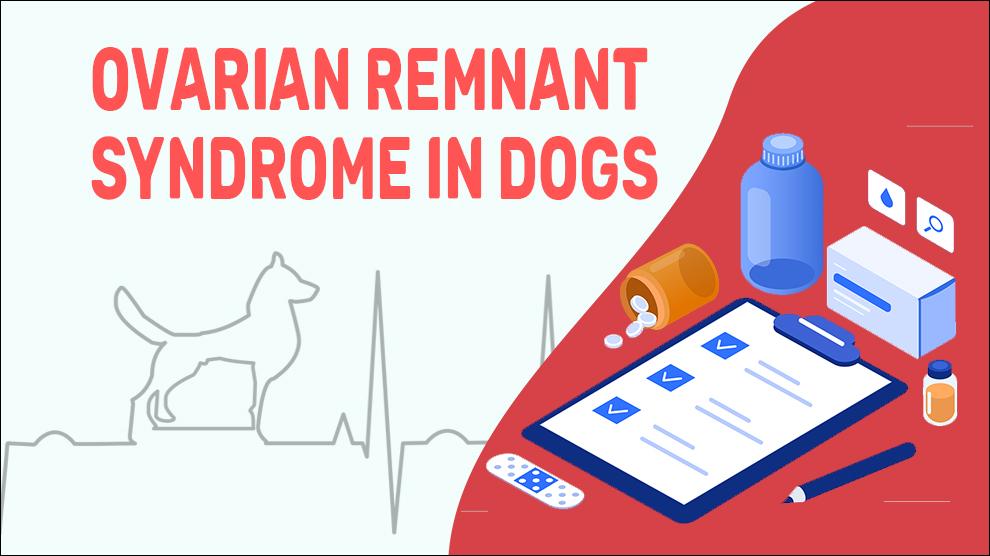Ovarian remnant syndrome (ORS) is a gynecologic diagnosis that occurs due to the presence of symptomatic residual ovarian tissue, usually following a complete ovariohysterectomy (after a female dog is spayed).
By definition, ORS is the existence of histologically confirmed residual ovarian tissue in a previously ovariohysterectomized dog.
In 1970, Shemwell and Reed first described ORS by using a feline model. They demonstrated that ovarian specimens, even after ligation of the blood supply, are able to re-implant and become functional.
ORS can occur in the dog because of poor visualization of the surgical field or improper placement of ligatures or clamps, or accidentally dropped ovarian cortex revascularization. In the abdominal cavity, remnants from the ovary may re-implant anywhere in the bowel, ureters, and bladder.
ORS complications include the uterine stump pyometra, mammary neoplasia, and formation of granulosa cell tumors; thus surgical exploration and excision of the ovarian remnants are highly recommended.
Symptoms Of Ovarian Remnant Syndrome
- Constant, Chronic Pelvic Pain.
- Blood-tinged Vaginal Discharge.
- Swelling of the vulva.
- Lifting the tail (flagging).
- Increased licking of the vulva.
- Behavioral changes (more receptive to males).
- Painful Urination and Bowel movements.
Treatment Options For Ovarian Remnant Syndrome
Surgery: The best time to perform the exploratory laparotomy is when the dog’s ectopic tissue is functional and enlarged (when the dog is in heat). If the remnant cannot be identified, surgery may not be successful and some dogs are not good candidates for surgery or anesthesia.
Medical Management: Milbolerone (30–180 mcg/day, PO) or (Ovaban, Megace) can be used to prevent the dog from going into heat, but surely they have side effects.
Home Remedies For Ovarian Remnant Syndrome
Pet owners may not notice the few clinical signs and the condition in its early stages of development.
Some may find it when the dog is being bathed or groomed or during a routine physical examination.
As ORS happens due to an error in gynecological surgery, spaying your dog properly is the suggested method of treatment in most cases because it takes away the risk of future or recurring infection.
Visit the veterinarian to examine the dog after initial symptoms. From there, the vet can help to find out the remnants and decrease the chances of triggering a uterine infection.
Prevention Of Ovarian Remnant Syndrome
The only way of prevention is by performing the ovariohysterectomy (removal of uterus and ovaries) properly.
Meticulous surgical techniques are required for visualization and sufficient exposure for the proper adhesiolysis (a surgical procedure that removes abdominal adhesions) of the adnexa away from the pelvic sidewall.
The best approach for the primary prevention of an ovarian remnant is retroperitoneal dissection, mobilization of the rectum, and ureterolysis to achieve sufficient tissue margins around the adherent ovary.
Affected Breeds Of Ovarian Remnant Syndrome
Female Dogs
Additional Facts For Ovarian Remnant Syndrome
- Causes:
- Improper surgical techniques or compromised surgery in which one or both ovaries are not completely removed.
- ORS incidence appears to have increased in the last few years, perhaps linked to the increased use of laparoscopic surgeries.
- During surgery, accidentally dropped ovarian cortex into the abdominal cavity revascularizes itself and becomes functional again.
- Ectopic Ovarian Tissue - (A rare ovarian abnormality in which tissue functions like an ovary, but it is in another location, such as the abdominal wall near the ovary or ovarian ligament).
- Risk Factors:
- History of Endometriosis.
- Previous Abdominal or Pelvic Surgeries.
- Pelvic Inflammatory Disease.
- Pelvic Adhesions.
- Morbidity:
In an unspayed dog, the ovaries (female gonads) produce female sex hormones including estrogen and progesterone. Estrogen triggers your dog to go into heat (6 to 8 months on average) as it is produced in significant amounts during the estrous cycle. Spaying your dog means the entire reproductive tract (both uterus and ovaries) is surgically removed. The spayed dog has no ovaries; so estrogen is not produced and has no estrous cycle. However, when a previously spayed dog shows signs of going into heat, this may indicate that an ovarian tissue function (ovarian remnant) is still going on and producing estrogen.
- Mortality:
Ovarian remnant syndrome is not potentially life-threatening and there is no documented mortality rate.
- Diagnosis:
- Vaginal Cytologic Evaluation
- Hormone Challenge Testing
- Anti-Muellerian Hormone Test
- Resting Hormone Assays
- Abdominal Ultrasound
- Prognosis:
The prognosis is really good for ORS. As the existing condition is not life-threatening, no rigorous treatment is usually necessary. However, proper spaying is enough to prevent this from happening.
When To See A Vet
Contact your vet right away, if you notice any of the following:
- Symptoms of “going into heat” period.
- Blood-tinged vaginal discharge.
- Swelling of the vulva
Food Suggestions For Ovarian Remnant Syndrome
- Commercial foods should have high-quality, natural ingredients, with no artificial additives.
- Add fiber to your pup’s diet.
- Brown rice, Lukewarm (never hot) chicken soup with Low sodium or chicken breast, and cooked vegetables are perfect for the ailing pup.
- Add a couple of spoonfuls of salmon, tuna, mackerel, anchovies, or another fish product to your dog’s food.
- Meat-flavored baby food or bland food.
- Semi-moist pet food with boiled chicken.
- Increase water intake or install a pet water fountain.
Conclusion
Surgical treatment for this condition may be difficult as the hardships in the initial surgery or inadvertent droppings of ovarian tissues during the surgery were the reason for the cause of ORS in the first place.
Highly qualified providers who are experienced in operating in the setting should perform the procedures to remove ovarian remnants. On a positive note, dogs in which ovarian remnants that were effectively removed are always cured of their pain.

















